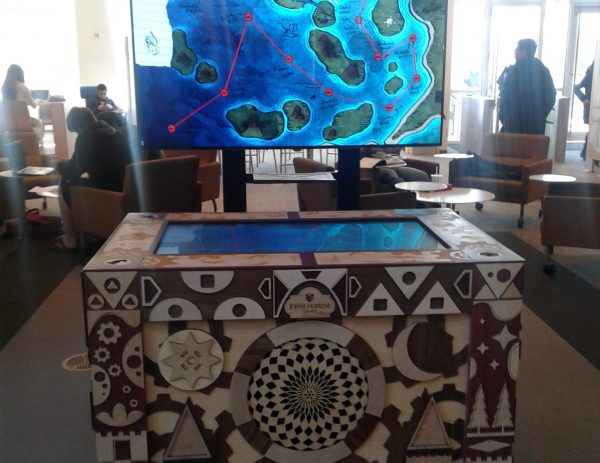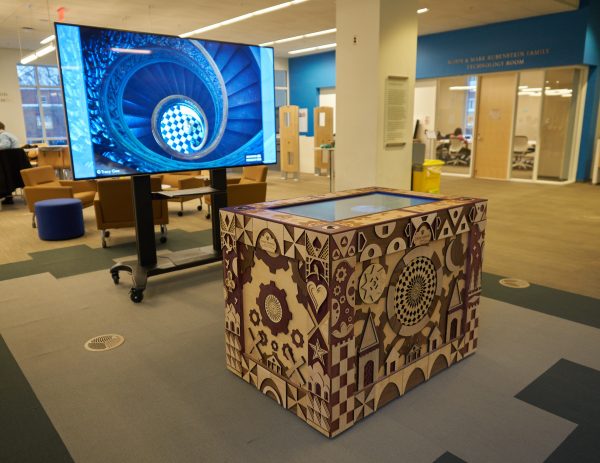Students come to Brody Learning Commons for lots of reasons, from studying to working on projects to socializing with friends. Soon they will be able to add “helping patients recover from stroke and brain injury” to that list, thanks to the installation of a special gaming table in BLC’s lower level.
Called the “Kata Therapeutic Table,” this device – once fully operational early this fall – will allow students, faculty and staff to play video games remotely with neurology patients at the Johns Hopkins Hospital. The games they will play have been specially designed to give neurologically impaired players a dynamic, immersive experience that helps stimulate brain recovery.
 The table and screen are the creations of the Kata design group, based in the Department of Neurology at the Johns Hopkins School of Medicine, and affiliated with the Malone Center for Engineering in Healthcare in the Whiting School of Engineering.
The table and screen are the creations of the Kata design group, based in the Department of Neurology at the Johns Hopkins School of Medicine, and affiliated with the Malone Center for Engineering in Healthcare in the Whiting School of Engineering.
The group, led by Omar Ahmad, Director of Innovative Engineering in the Department of Neurology and Neuroscience, and a member of the Malone Center, brings engineers and neuroscientists together with artists, technicians and entertainment industry specialists with the aim of devising new ways to help people recover from neurological diseases and injuries. Inspired by the clinical research and findings of the John C. Malone Professor of Neurology and Neuroscience, John Krakauer, Kata aims to revolutionize stroke rehabilitation, and the interactive table is just one of the many innovative ideas they are exploring and implementing.
The table is remarkable in many ways, from the games it will facilitate to its ornate wooden framework, which features three types of wood. Under Ahmad’s creative direction, Jarreau Wimberly, Kata’s primary artist, designed the playful, aesthetically pleasing outer frame. Wimberly took inspiration from Disney’s “It’s a Small World” exhibit, which features angular cutouts and a whimsical sense of place. Embedded in the table is a 4K touch-screen, which eventually will connect student players with patients. According to Ahmad, each element of the setup was designed with the needs of those patients in mind.
 “We have been interested in multiplayer games for a while, so it wasn’t a big leap from multiplayer to the idea of having patients at the medical center play remotely with others outside of the hospital and rehab center,” he said.
“We have been interested in multiplayer games for a while, so it wasn’t a big leap from multiplayer to the idea of having patients at the medical center play remotely with others outside of the hospital and rehab center,” he said.
Though the Kata team initially envisioned installing the table in hospitals and waiting rooms – settings close to patients — they soon realized that the Johns Hopkins Homewood campus presented them with an opportunity for easy access to the largest “gaming community” one could find at the university: students.
The Brody Learning Center Auditorium, where the interactive table and touchscreen have been installed, seemed the ideal location because of its visibility, and its popularity as a student gathering place.
Though the table won’t be operational for use with patients until the fall, single players are already using it to play Kata’s “Bandit Shark Showdown” game, which features the realistic dolphin, “Bandit,” fighting off menacing sharks.
Over the next four months, the team will install a local multi-player game, allowing two students to play together. Later, the table will connect remotely to the medical center, allowing four players — students and patients — to compete simultaneously. To enable that, Kata software wizard Promit Roy is developing a custom framework for intricate network-based multiplayer physics, a characteristic in Kata’s experience designs.
“The challenge here” says Roy, “is to push physics state information over the network in far more detailed ways than are done in traditional AAA games.”
